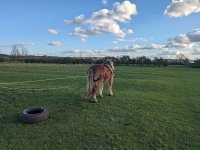We live in an area known as the West Midlands. Birmingham is an hour away, Coventry half an hour and then there are smaller yet sizeable towns like Rugby and Leamington Spa which are quite close.Tharg - where are you located in the UK - nearest larger city? The north and highlands gets some snow, then the south, Devon/Cornwall region little.
Assume rolling hills and pasture land?
It is pretty flat where we are. Our land slopes very gently towards the nearby river Leam and is covered in shallow ridge and furrow ( you can just about make It out in the photo).It is not rolling hills but is pasture land ideal fro sheep and cows.
The area doesn't suffer from extremes of weather. However, the ground is wet from October to May. We are on clay and once the rains start, the ground remains soft for a long time. After a storm, we might get pools of water but, given the chance , they go but leave the ground soggy
For all you historians out there , we are next to an abandoned mediaeval village. Some say it was abandoned as a result of the Plague; others that a natural decline in population was brought about by diminishing returns from the land which was becoming less and less fruitful.
Some of the ridge and furrow was partly the remains of mediaeval strip farming; Some was the result of more modern attempts to provide dry ridges of land for grazing animals.
Attachments
Last edited:

